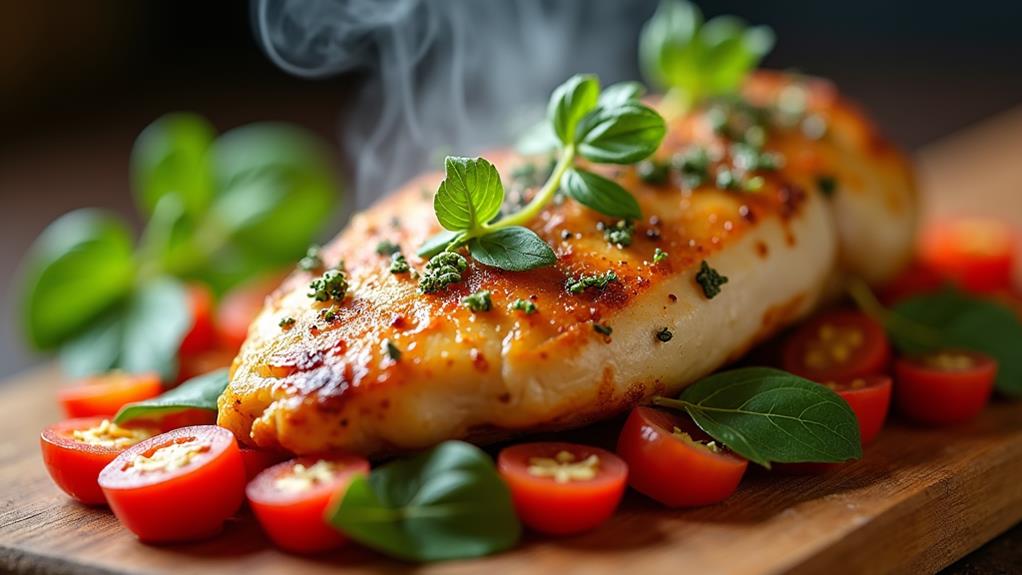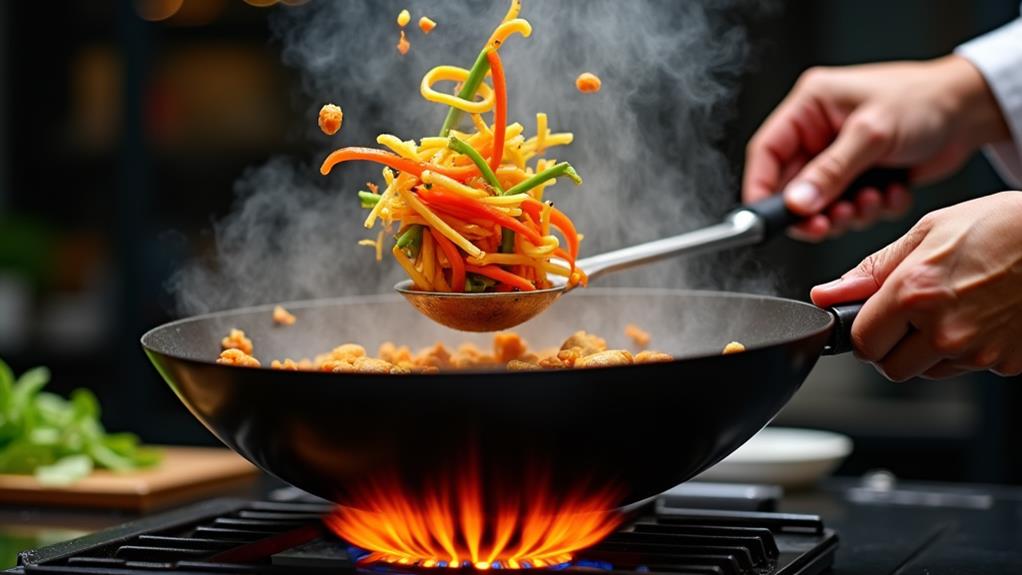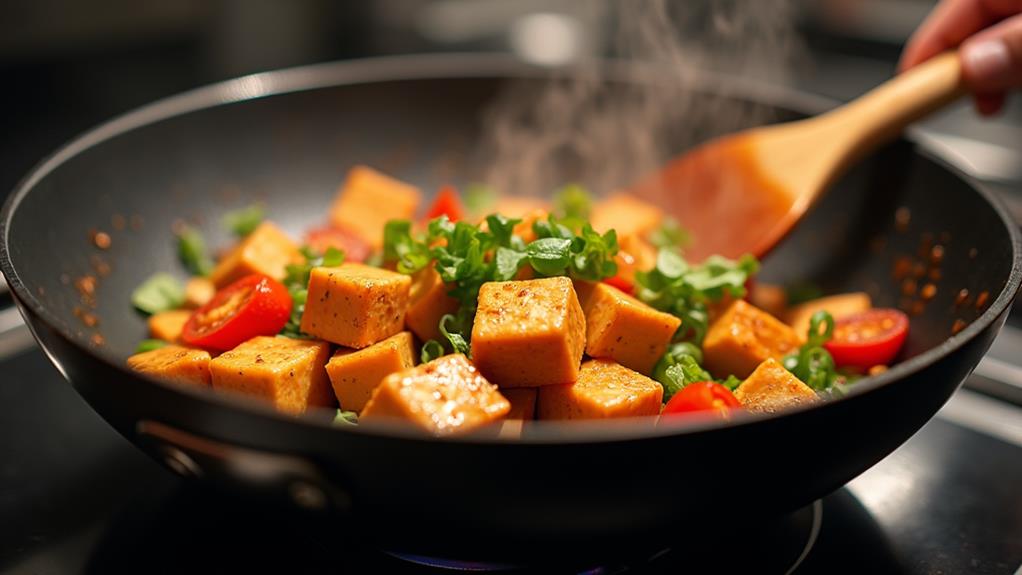To transform ordinary sautéed chicken into a flavor sensation, start by selecting high-quality meat and marinating it in a blend of oil, acid, herbs, and spices for at least 30 minutes. Master the sauté technique by preheating your pan properly and avoiding overcrowding. Create aromatic foundations using fresh herbs like rosemary, thyme, and sage, combined with garlic and lemon. Experiment with spice blends, mixing sweet and savory elements for depth. Boost flavors with a splash of acid near the end of cooking, and deglaze the pan with wine for added complexity. Finally, garnish with colorful herbs, edible flowers, or toasted nuts for visual appeal and texture. These secrets will elevate your chicken dish to new heights.
Prepping for Flavor-Packed Chicken
To kick off your flavor-packed chicken journey, proper preparation is key. Start by selecting high-quality, fresh chicken breasts or thighs from a reputable source. Ingredient sourcing plays a crucial role in elevating your dish, so don't skimp on this step.
For instance, using seasonal ingredients can enhance the freshness and overall flavor profile of your dish, such as when paired with honey mustard chicken thighs that highlight spring vegetables. Once you've secured your poultry, it's time to dive into marinade magic.
Create a base marinade using a combination of oil, acid (like lemon juice or vinegar), and your choice of herbs and spices. Experiment with unique flavor profiles by incorporating ingredients such as soy sauce, ginger, garlic, or even fruit juices.
For optimal results, allow your chicken to marinate for at least 30 minutes, or up to 24 hours for more intense flavor infusion.
Before cooking, remove the chicken from the marinade and pat it dry with paper towels. This step ensures a crispy exterior when sautéing. Let the chicken come to room temperature for about 15 minutes, which promotes even cooking.
Season the chicken with salt and pepper just before it hits the pan, as salt can draw out moisture if applied too early.
Mastering the Sauté Technique
The key to mastering the sauté technique lies in achieving the perfect balance of heat, timing, and movement. To revolutionize your chicken sauté, start by preheating your pan to the ideal temperature. You'll know it's ready when a drop of water sizzles and evaporates instantly. This sauté temperature control is crucial for creating that coveted golden-brown exterior and is reminiscent of achieving the perfect crust in a chicken pot pie, which results in a delightful contrast to the creamy filling a flaky crust.
Once your pan is hot, add your seasoned chicken pieces. Don't overcrowd the pan, as this will lower the temperature and lead to steaming rather than sautéing. Cook in batches if necessary.
As the chicken cooks, resist the urge to constantly move it. Instead, let it sit for a few minutes to develop a flavorful crust before flipping.
Cooking time optimization is essential for juicy, tender results. Use a meat thermometer to ensure the internal temperature reaches 165°F (74°C).
As you near the end of cooking, you can add aromatics like garlic or herbs to infuse additional flavors. Remember, the goal is to create a harmonious blend of textures and tastes that elevate your sautéed chicken from ordinary to extraordinary.
Aromatic Flavor Foundations
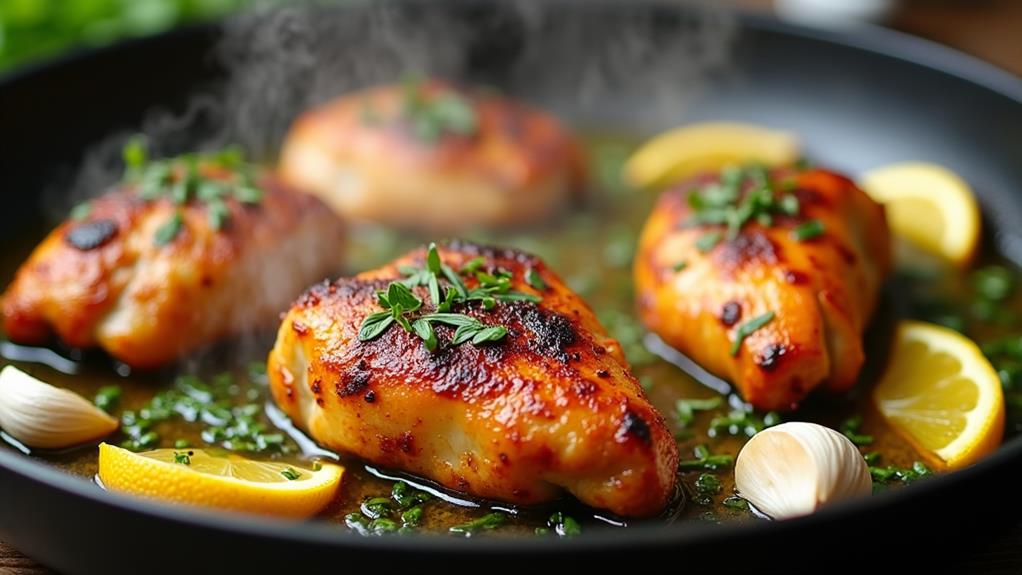
Building on the foundation of perfect sauté technique, aromatic flavor profiles take your chicken dish to new heights. The key to transforming ordinary chicken into a culinary masterpiece lies in your herb selection and marinade magic.
By carefully choosing complementary herbs and spices, you'll create a symphony of flavors that tantalize the taste buds. Incorporating fresh herbs, such as those used in a delicious Herby Spring Chicken Pot Pie, can add freshness and depth to your dish.
When selecting herbs, consider these aromatic powerhouses:
- Fresh rosemary: Its robust, piney flavor pairs beautifully with chicken.
- Thyme: Offers a subtle, earthy note that enhances without overpowering.
- Sage: Provides a warm, slightly peppery taste that complements poultry.
For marinade magic, combine your chosen herbs with garlic, lemon juice, and olive oil. This mixture not only imparts flavor but also tenderizes the meat.
Let your chicken marinate for at least 30 minutes, or ideally overnight, to allow the flavors to penetrate deeply.
As you sauté, the aromatic compounds in your herbs will release, creating an enticing aroma that fills your kitchen. This foundation of flavors will elevate your chicken dish from ordinary to extraordinary, impressing even the most discerning palates.
Spice Blends for Taste Explosion
Spice blends offer a powerful way to elevate your sautéed chicken to new heights of flavor. By combining various herbs and spices, you'll create unique taste profiles that transform ordinary poultry into an extraordinary culinary experience.
Start by experimenting with classic herb combinations like rosemary, thyme, and sage, or venture into more exotic territory with za'atar or garam masala. The key lies in finding the right seasoning ratios to achieve a harmonious balance of flavors.
To craft your own signature blend, begin with a base of salt and pepper, then add layers of complexity. Consider incorporating dried herbs, ground spices, and even citrus zest for brightness.
Don't be afraid to mix sweet and savory elements, such as paprika with a touch of brown sugar. For a smoky kick, try chipotle or smoked paprika.
Remember, the goal is to enhance, not overpower, the natural flavor of the chicken. Start with small amounts and adjust to taste, keeping in mind that some spices intensify during cooking.
Acid Splash Flavor Boost
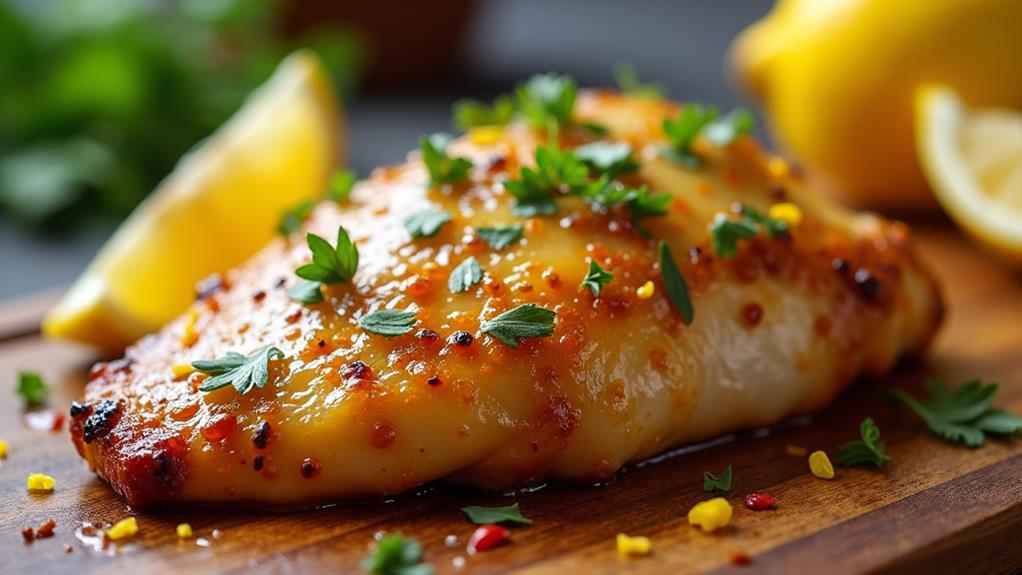
Three key acids can dramatically boost the flavor of your sautéed chicken: citrus juice, vinegar, and wine. These ingredients add brightness and depth, elevating your dish from ordinary to extraordinary.
When incorporating acids, timing is crucial. Add them towards the end of cooking to preserve their vibrant flavors and prevent them from becoming too muted.
Experiment with citrus infusions to create unique flavor profiles. Try these innovative combinations:
- Blood orange and rosemary
- Meyer lemon and thyme
- Lime and cilantro
Don't limit yourself to just lemon juice; explore the wide world of vinegar varieties. Balsamic, apple cider, and rice wine vinegars each bring their own distinct characteristics to your chicken.
For a sophisticated twist, deglaze your pan with wine after sautéing. White wine adds a crisp acidity, while red wine imparts a rich, complex flavor.
Garnishing for Visual Appeal
The final touch to elevate your sautéed chicken dish lies in its visual presentation. By carefully selecting and arranging garnishes, you'll transform your meal into a feast for the eyes as well as the palate.
Start with a vibrant base of colorful herbs, such as fresh parsley, cilantro, or basil, scattered artfully around the plate. These not only add visual interest but also provide aromatic notes that complement the chicken's flavors.
For a truly innovative touch, incorporate edible flowers into your garnish. Nasturtiums, with their peppery taste and bright hues, or delicate violet petals can add unexpected elegance to your dish.
Don't overlook the power of contrasting textures; consider adding a sprinkle of toasted nuts or seeds for a satisfying crunch. Micro-greens, with their delicate appearance and concentrated flavors, can create a sophisticated, restaurant-quality look.
Frequently Asked Questions
Can I Use Frozen Chicken for Sautéing?
You can use frozen chicken for sautéing, but it's not ideal. Thaw it first for better results. Innovative sautéing techniques work best with fresh chicken, as it allows for even cooking and optimal flavor development.
How Long Can I Store Leftover Sautéed Chicken?
Safely store your savory sautéed chicken in the fridge for up to four fantastic days. For futuristic freshness, freeze it for three months. When reheating, revolutionize your leftovers with a quick pan-sear or microwave magic for optimal taste and texture.
What's the Best Oil for Sautéing Chicken?
For sautéing chicken, you'll want oils with high smoke points. Try avocado, grapeseed, or refined coconut oil for a cutting-edge approach. These options won't break down at high temperatures, ensuring a perfect sear and optimal flavor infusion.
Are There Vegetarian Alternatives That Work Well With These Techniques?
Absolutely! You'll be cooking up a storm with vegetarian substitutes. Try firm tofu, seitan, or tempeh as your protein base. Enhance flavors with umami-rich ingredients like mushrooms, miso, or nutritional yeast. Get creative and experiment!
How Do I Adjust Cooking Times for Different Chicken Cuts?
You'll need to adapt your cooking techniques for different chicken cuts. For breasts, aim for 6-8 minutes per side. Thighs take longer, about 12-15 minutes. Wings cook quickly in 8-10 minutes. Always check for desired chicken textures and doneness.
Final Thoughts
You've now unlocked the secrets to elevating your sautéed chicken from ordinary to extraordinary. By mastering these techniques, you'll create dishes bursting with flavor that'll impress family and friends. Did you know that marinating chicken for just 30 minutes can increase its flavor absorption by up to 40%? Remember, the key to mouth-watering chicken lies in layering flavors, balancing spices, and perfecting your sauté technique. With practice, you'll soon be crafting restaurant-quality meals in your own kitchen.

